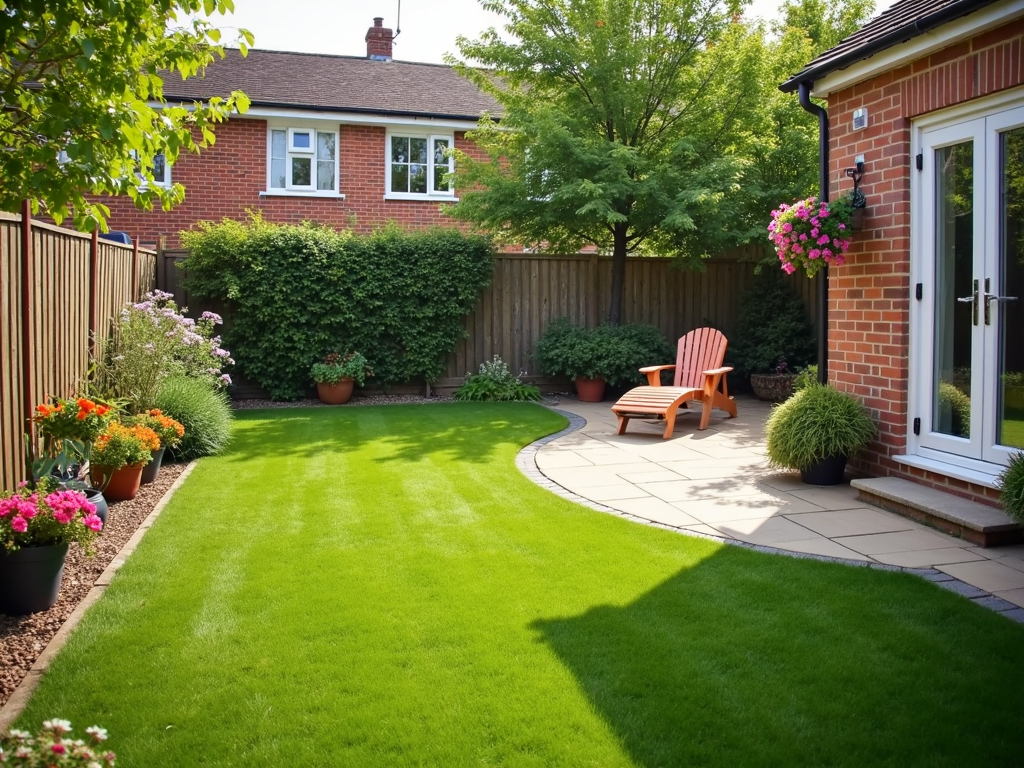
Overview
In Shropshire, a defined lawn edge is one of those subtle but powerful features that can make all the difference to your garden. It gives your outdoor space a clean, polished look that can’t be achieved by mowing alone. With the right tools and a bit of technique, you can turn an average lawn into a professionally landscaped one. It’s something we focus on a lot at Luxe Gardens, as it’s a simple way to give any outdoor space an instant lift and a more refined finish. Whether you’re maintaining your garden or giving it a refresh, learning the art of edging a lawn is a valuable skill to master.
Lawn edges don’t just make your grass look neat – they serve a purpose, too. They create a clear and intentional boundary between your lawn and other elements like flower beds, garden borders, gravel paths or patio areas.
Edging establishes a defined perimeter in your garden, helping to organise and unify the space. This stops grass from creeping into places it shouldn’t be and defines the layout of your garden. Edging also creates a tidy and organised appearance that enhances the overall look of your landscape. A well-edged lawn brings structure to your space and can make even a small garden look thoughtfully designed.
There’s something so satisfying about the crisp, clean line of a freshly edged lawn. It immediately says the garden is loved and cared for. A tidy edge can make a big impact even if you’ve done nothing else that day.
Proper edging results in a neater lawn and garden, giving your outdoor space a more professional and polished appearance. It’s a small detail that makes your whole garden feel more “together”, and it’s a favourite trick among landscapers for making any outdoor space look more refined.
There’s something deeply satisfying about the look of a freshly edged lawn. Even if you’ve done little else, a tidy edge gives the impression of a cared-for space. It’s one of those small details that makes a big impact—
something we often recommend to customers who want their outdoor areas to feel more complete.
Edging a Lawn Techniques for a Professional Finish
Getting that professional look on your lawn edges starts with the right techniques and a bit of planning. Whether you’re edging for the first time or refreshing existing ones, it’s easy with the right tools. You can go manual with a half-moon edger or go powered for faster results—both will give you a beautiful finish if used correctly.
Before you start cutting into the lawn, map out your edge. To mark straight or curved lines for precise edging, use two canes and a string as a guide. A garden hose or a piece of rope works well to visualise the shape, especially if you’re going for curves.
Once you’re happy with the layout, take a sharp spade and remove any excess soil and turf to create a visible divide. For a clean removal, slide the spade underneath the turf to lift it away. This sets the foundation for a neat and long-lasting edge and helps you stay on track.
For precision, a half-moon edger is a gardener’s best friend. Regular trimming of the edge will help maintain a sharp and tidy appearance. It’s great for cutting through turf cleanly and neatly. If you’re going for a straight edge—say, along a path or patio—you might want to use a wooden board or even a metal edging strip as a guide. These will help you keep the line straight and give you a uniform finish, especially if you’re a perfectionist.
For curved borders, a bit more flexibility is needed. Plastic or metal edging materials that bend easily are perfect for following a flowing line. As you work along the curve, keep lifting away any loose soil and grass to keep it looking sharp. This attention to detail as you go makes all the difference, leaving you with a lawn edge that’s both practical and pretty. If you need to repair or adjust the edge, you can extend the lawn boundary by repositioning or cutting turf.
The best times of year for edging are spring, summer, and autumn, when grass is actively growing and can recover quickly. New edges are best created during these seasons to ensure a healthy, well-defined lawn boundary.
Creating a New Lawn Edge
Creating a new lawn edge is a rewarding way to give your garden a crisp, defined look. Start by marking out where you want your new lawn edge to go—lay a garden hose or rope along the desired line to act as your guide. This step is especially helpful for both straight edges and sweeping curves, ensuring you get the shape just right before you start cutting.
Once you’ve marked your line, grab the right tools for the job. A half moon edger or a sharp spade is ideal for cutting into the turf and soil. For straight edges, place a straight edge or a wooden board along your guide to help you achieve a perfectly clean cut. Simply press the blade down along the board, working your way along the length of the edge. For sweeping curves, follow your hose or rope with a manual edger, taking care to keep the curve smooth and even.
As you cut, remove excess soil and turf to create a visible, defined edge. Use your spade to tidy up the sides and ensure the soil is level. This process not only forms a clean separation between lawn and beds, but also helps create a border that clearly defines the layout of your garden.
This step is particularly important when reworking older gardens, where lines have softened or vanished over time—a common sight in many Shropshire gardens that haven’t been refreshed in a while.

Garden Edging Options
When it comes to edging your lawn or garden beds the material you choose can have a big impact – not just on the look of your garden but how easy it is to maintain. There are several popular edging materials to choose from, each with its own strengths and style. Lawn edging fencing is available in various materials, offering versatility in design and durability to match different garden styles. Whether you’re going for modern and sleek or rustic and charming there’s an edging option to suit your vision and budget.
Metal edging is a popular choice for its strength and ability to form clean lines. It’s brilliant for modern gardens and more formal layouts, and it tends to stay in place with minimal fuss. We often recommend it for clients looking for long-lasting results.
Metal edging is often used for garden borders and along garden paths and driveways to achieve a professional, finished look. Once installed, metal edging tends to stay in place and requires very little maintenance, so it’s a long-term investment for your garden.
If you’re on a smaller budget or prefer something lightweight and easy to handle, plastic edging might be more your thing. It’s widely available and usually cheaper than metal. While it may not be as long-lasting, especially in gardens with lots of foot traffic or extreme weather, it still does a great job of keeping grass and soil in place. It’s especially useful for defining flower beds, paths and other softer edges in your landscape. Plastic edging is also a cost-effective way to protect flowerbeds and can be installed by using a mallet to simply tap it into the ground.
For those who prefer a more natural look, wood and stone edging can add warmth and character to your outdoor space. Timber edging looks great with cottage-style gardens, while stone offers a sturdy, timeless feel. Both can create a really striking effect, but worth noting they may require a bit more maintenance over time. These options are especially effective in more traditional gardens, which are often found throughout Shropshire’s charming villages and older homes.
When installing stone or paving edging, use sand as a base layer to ensure stability and proper placement. Wood can rot and stone can shift if not properly set. But if you’re after a unique and earthy finish these materials are worth the effort. Choosing the right colour for your edging materials can further enhance the overall look and complement your garden design.
Some modern edging systems use locking mechanisms where you pull tabs through slots to secure the edge, making them the ideal solution for quick and durable installation.
Using an Edging Tool
An edging tool is your best friend when it comes to achieving a professional finish on your lawn edge. There are several types to choose from, including the classic half-moon edger, manual edgers, and sturdy metal edging tools. The right tool depends on the type of edge you want to create and the specific needs of your lawn.
To create a clean cut, position your edging tool along your marked line. For straight edges, use a straight edge or a wooden board as a guide—this helps you keep the line perfectly straight as you work. If you’re aiming for sweeping curves, lay out a hose or rope to follow, and use your edging tool in a gentle, controlled motion to trace the curve.
As you edge, be sure to remove excess soil to keep the line sharp and defined. Work steadily, using the edging tool in a smooth, sweeping motion for the best results. Whether you’re working with metal edging for a modern look or a manual edger for more control, taking your time with the right tool will help you create a lawn edge that looks crisp and polished.
At Luxe Gardens, we like to give a little extra time to this part of the job—it’s where the whole lawn starts to come together and feel complete.
Lawn Edging Ideas
If you want to add definition and polish to your garden, start by exploring lawn edging ideas. One of the most popular methods is installing a straight edge using metal or plastic edging strips. This creates a sharp, modern look and neatly separates grass from paths, patios, or flower beds. You can also use materials like caged rocks, bamboo, or decorative stones to define the edge and boost visual appeal. The result is a clean line that lifts the whole garden.
If you’re looking to soften the layout or introduce flow, sweeping curves are a great alternative. Curved borders bring movement and organic beauty to your design. They work especially well in larger lawns where straight lines may feel too rigid. With flexible edging like bendy plastic or pliable metal, you can create smooth, flowing lines that add charm and character. It’s a subtle design choice that makes a big difference, especially in natural-style gardens.
Trying different lawn edging ideas can spark unique design choices that reflect your garden’s layout and personality. Whether you’re planning a modern makeover or enhancing a traditional space, thoughtful edging helps you achieve a cohesive, polished look. Edging around flower beds or patios adds structure and style. Well-defined edges also help stop weeds from spreading and keep grass from creeping into unwanted areas—they act as a tidy, effective frame.
Shropshire gardens, rich in character, lend themselves well to these bespoke touches. Mixing materials can take your edging to the next level—combine wood with metal or stone with plastic for a custom look. These contrasts can tie different areas together and add creative flair. Don’t be afraid to experiment—your ideal edging design should reflect your personal style and suit your space. Adding seating within edged zones also creates inviting spots to relax and enjoy.

Achieving a Flawless Finish
To achieve a flawless finish on your lawn edge, it’s all about the details. Start by using your edging tools to create a smooth, even cut along the edge of your lawn. Once you’ve established the line, remove any excess soil and debris to keep the area neat and tidy.
Next, use a garden rake to level the soil and create a seamless transition between the lawn and the border. Mow the grass right up to the edge to ensure a sharp, clean line, and use a pair of shears to trim any stray blades that might be sticking out. This extra step makes a big difference in achieving that professional, finished look.
Finally, give your new lawn edge a gentle watering to help settle the soil and keep everything looking fresh. With a little attention to detail and the right tools, you’ll create a flawless finish that makes your garden stand out.
Common Mistakes to Avoid
Even the best intentions can go awry if you’re not careful with your lawn edge. One common mistake is not using the right tools—skipping a half moon edger or metal edging tool can leave you with a ragged, uneven edge. Always choose the right tool for the job to ensure a clean, defined line.
Another pitfall is failing to remove excess soil and debris as you work. Leaving this behind can result in a messy, uneven surface that spoils the look of your lawn. Always clear away soil and use a wooden board or straight edge as a guide, especially for straight edges, to avoid wavy or crooked lines.
Don’t forget to trim the grass regularly along your lawn edge. Neglecting this step can quickly lead to an overgrown, untidy appearance. Similarly, not watering the edge can cause the soil to dry out and crack, undermining your hard work. Finally, regular maintenance is key—if you let your edges go, they’ll become difficult to repair and lose their sharp, polished look. By avoiding these common mistakes and sticking to best practices, you’ll keep your lawn edges looking neat and professional all season long.
Garden Design Considerations
When designing your garden, start with a clear idea of the style and vibe you want to achieve. Whether modern and minimal, cottage or traditional, your lawn edging should support and enhance that theme. Edging isn’t just a finishing touch—it’s part of the overall design that ties everything together and gives the space structure.
Take a moment to think about the colours and textures of the materials you’re considering. Smooth metal might suit a contemporary garden, while rustic wood or natural stone would work better in a more relaxed, country setting. Also, think about how these materials will work with your plants, shrubs and hardscaping. A well-chosen edging material can really make the surrounding greenery pop, and using a good garden edging tool will ensure the lines are sharp and professional-looking.
Practicality plays a big part too. Some edging materials require more maintenance than others, so factor in how much time and effort you’re willing to put into garden maintenance. For example, metal and plastic are low maintenance and long-lasting, while wood and stone need more attention over time. Choosing the right material is about balancing your aesthetic goals with your daily routine and budget—after all, your garden should be enjoyable, not overwhelming.
Ultimately, your garden should be a reflection of you and your lifestyle. The right lawn edging technique or material can subtly lift the whole space and make it feel cohesive and designed. Don’t rush the decision, take your time and think about what will work best in your space. With a bit of planning, lawn edging becomes more than just a boundary—it becomes part of your garden’s identity.
About Luxe Gardens
At Luxe Gardens, we believe the little things—like a perfectly edged lawn—can make a huge difference to the look and feel of your outdoor space. Whether you’re updating an existing garden or starting fresh, we help homeowners achieve polished, purposeful results with a friendly, professional touch.
We offer expert lawn edging, garden design, and maintenance services tailored to your space and needs. From smooth, sweeping borders to crisp, clean lines, we’re passionate about helping your garden look its best year-round.
If you’re looking to upgrade your lawn edges or give your garden a bit of love, Luxe Gardens is here to help—no stress, no fuss, just beautiful results.
Contact us today to get started.

